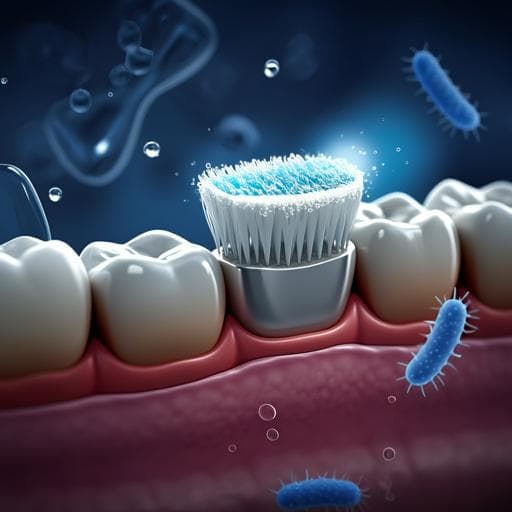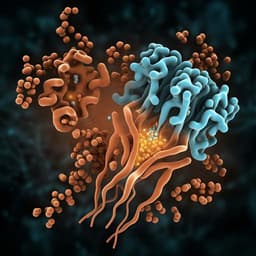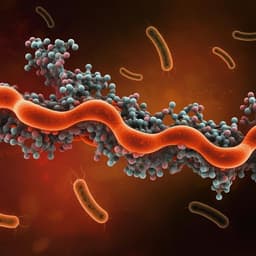
Medicine and Health
Inhibitory and preventive effects of *Arnebia euchroma* (Royle) Johnst. root extract on *Streptococcus mutans* and dental caries in rats
Z. Wu, J. Song, et al.
This exciting study by Zeyu Wu, Jie Song, Yangyang Zhang, Xiyu Yuan, and Jin Zhao reveals the powerful antibacterial properties of *Arnebia euchroma* root extract against *Streptococcus mutans*, showcasing its potential in preventing and treating dental caries with excellent biosafety. Discover how this natural solution could change dental care!
~3 min • Beginner • English
Introduction
Dental caries is a chronic biofilm-mediated disease driven by sucrose and influenced by multiple factors. Globally, caries in permanent and deciduous teeth remains highly prevalent, including in Chinese children. Among oral bacteria, Streptococcus mutans is a principal cariogenic agent due to its abilities to synthesize water-insoluble glucans, form stable biofilm matrices, adhere to tooth surfaces, and maintain an acidic microenvironment. While agents such as fluoride and chlorhexidine (CHX) are used for caries control, overuse of CHX can cause oral dysbiosis and promote drug-resistant organisms. Ecological approaches focusing on maintaining a healthy biofilm, including natural products, are gaining attention. Arnebia euchroma, widely used in traditional medicine in Xinjiang, Tibet, and Mongolia, contains bioactive components (e.g., naphthoquinones) with antibacterial and anti-inflammatory effects. Prior in vitro work suggested AR extract inhibits growth, acid production, and polysaccharide production of cariogenic bacteria, but its effects on S. mutans adhesion and in vivo caries prevention and safety had not been investigated. This study aimed to evaluate AR extract’s effects on S. mutans growth, biofilm, adhesion, and its anti-caries efficacy and safety in a rat model.
Literature Review
The manuscript situates the study within ecological caries prevention, highlighting limitations of CHX (e.g., dysbiosis, resistance) and the promise of natural compounds. Arnebia euchroma is rich in naphthoquinones (e.g., shikonin and derivatives), phenolic acids, alkaloids, and terpenoids with reported antibacterial, anti-inflammatory, and antioxidant activities. Prior studies show shikonin derivatives exhibit strong antibacterial activity, particularly against gram-positive bacteria, and can modulate quorum sensing and biofilm formation in various pathogens. Natural product-based approaches have shown anti-biofilm and anti-caries effects in vitro and in vivo. The authors’ earlier study indicated ethanolic AR extract inhibited growth, acid production, water-insoluble polysaccharide production, and adhesion of major cariogenic bacteria, motivating the present comprehensive evaluation.
Methodology
Ethics: Approved by the Ethics Review Committee of Xinjiang Medical University (IACUC-JIPD-2019030). Bacterial strain and culture: Streptococcus mutans UA159 (ATCC 700610) was grown in brain heart infusion (BHI) broth with 1% sucrose at 37 °C; standardized to 1.0×10^7 CFU/mL (OD630=0.2). Plant material and extraction: Dried Arnebia euchroma roots were authenticated, pulverized, and extracted with 95% ethanol (1:10 w/v) at room temperature, repeated three times. The extract was concentrated under vacuum (50 °C) and freeze-dried; stored at −4 °C. Chemical profiling: Components were analyzed by UHPLC-MS/MS (Thermo UltiMate 3000; AB SCIEX 5600+ TripleTOF). Identification used exact mass (≤30 ppm) and MS/MS databases (MassBank, GNPS, RIKEN PlaSMA, BMDMS-NP, mzCloud). Major classes included alkaloids, flavonoids, phenols, coumarins, and terpenoids, with shikonin derivatives prominent. In vitro antibacterial assays: MIC50 and MBC followed CLSI guidance for water-insoluble agents (2022/2023). AR extract was double-diluted in BHI with 1% DMSO to final concentrations 32–0.25 mg/mL; 0.12% CHX as positive control; untreated bacteria and BHI as negative controls; 1% DMSO solvent control. Cultures incubated 24 h at 37 °C with shaking; OD595 measured to compute inhibition. MBC: samples from wells ≥MIC50 were plated on BHI agar for 24 h; MBC defined as lowest concentration yielding no colonies. Biofilm assays: MBIC50 (inhibition of biofilm formation) and MBRC50 (reduction of established biofilm) were determined in 96-well plates; S. mutans grown in BHI +1% sucrose. For MBIC50, AR extract (32–0.25 mg/mL) was present during biofilm formation; after 24 h static incubation, wells were washed, methanol-fixed, crystal violet stained, eluted with 95% ethanol, and OD595 measured. For MBRC50, 24 h preformed biofilms were treated with AR extract (32–0.25 mg/mL) for 24 h and processed similarly. Live/dead staining of biofilms: Preformed biofilms on glass discs were treated with AR extract at 2, 4, and 8 mg/mL for 24 h (37 °C, anaerobic), with 0.12% CHX positive control, 1% DMSO solvent control, and BHI control. Biofilms were stained with DAPI/PI and imaged by fluorescence microscopy (×100). ImageJ quantified areas of live (blue) and dead (red/pink) bacteria; three random fields per sample. Adhesion to saliva-coated hydroxyapatite: Unstimulated saliva from a healthy volunteer was collected (consent obtained), clarified and filtered (0.22 µm). HAP-coated 96-well black plates were prepared with 5% (w/v) HAP in saliva, incubated and rinsed. S. mutans were labeled with BCECF/AM and co-incubated with AR extract (0.25–4.0 mg/mL) on saliva-coated HAP for 2 h at 37 °C in the dark with gentle shaking. Nonadherent bacteria were removed; adherent fluorescence (Ex 495/Em 525 nm) measured and normalized to control (=100% adhesion). Fluorescence microscopy documented adherence; five fields per sample. In vivo rat caries model: Forty-two SPF male SD rats (21 days old) were used. To reduce endogenous oral flora, rats received antibiotic water (benzylpenicillin 200 µg/mL; streptomycin 1500 µg/mL) and antibiotic-supplemented diet (1 g/kg) for 3 days. Rats were randomized into seven groups (n=6): AR extract 0.5, 1.0, or 2.0 mg/mL; 0.12% CHX (positive control); 1% DMSO (solvent control); double-distilled water (DDW, negative control); and no intervention (blank). S. mutans UA159 (500 µL, 1×10^8 CFU/mL) was inoculated onto rat teeth twice daily for 3 consecutive days; fasting 0.5 h pre- and post-inoculation. Interventions were applied topically to molars and oral mucosa twice daily (9:00 and 21:00) for 3 weeks using fresh aliquots per rat; residual solution used as rinse; fasting 0.5 h post-treatment. From days 27–47, rats were fed Keyes 2000 cariogenic diet and 5% sucrose water ad libitum. Body weight was monitored. Salivary bacteriology: On day 47, saliva was induced with pilocarpine and plated on Mitis Salivarius agar for S. mutans colony counts. Caries assessment: After euthanasia (day 48), jaws were harvested, autoclaved, cleaned, X-rayed (60 kV, 7 mA, 0.1 s), stained with 0.4% ammonium salt for 16 h, and examined by stereomicroscopy. Keyes scoring assessed smooth-surface and occlusal lesions: E (enamel), Ds (dentin exposed), Dm (3/4 dentin affected), Dx (all dentin affected). CLSM enamel imaging: Sagittal tooth sections (~300 µm) were stained with rhodamine B (0.1 mmol/L, 24 h, 37 °C) and imaged by CLSM; fluorescence intensity per lesion area quantified (ImageJ) as a proxy for demineralization. Safety evaluation: Buccal mucosa was H&E-stained. Heart, liver, spleen, lungs, and kidneys were weighed to calculate organ coefficients (organ weight/body weight×100%). Statistics: Normality and homogeneity tested; one-way ANOVA with LSD for parametric data; Kruskal–Wallis for nonparametric comparisons. P<0.05 considered significant. Data visualization with GraphPad Prism.
Key Findings
Chemical profiling: AR extract contained multiple bioactive classes, notably shikonin derivatives (e.g., shikonin, acetylshikonin, isovalerylshikonin), and other constituents (e.g., stigmasterol, coumarins). In vitro antibacterial activity: MIC50 against S. mutans UA159 was 1.0 mg/mL; MBC was 8.0 mg/mL. Biofilm assays: MBIC50 (formation) was 4.0 mg/mL; MBRC50 (reduction of established biofilm) was 8.0 mg/mL. Live/dead staining: AR extract disrupted biofilm architecture and increased dead-cell proportion dose-dependently. Quantitatively, dead/live biomass (%): Control vs solvent were similar (~3.5% dead/96.5% live). At 2 mg/mL: 11.58% dead/88.42% live; 4 mg/mL: 31.49% dead/68.51% live; 8 mg/mL: 73.06% dead/26.94% live. At 8 mg/mL, killing exceeded that of 0.12% CHX (P<0.05); 4 mg/mL was similar to CHX. Adhesion to HAP: AR extract reduced adhesion of BCECF/AM-labeled S. mutans to saliva-coated HAP in a concentration-dependent manner. Mean adhesion (% of control ± SE): 0.25 mg/mL 85.52±4.05; 0.5 mg/mL 77.00±6.45 (P<0.001); 1.0 mg/mL 50.93±6.36 (P<0.001); 2.0 mg/mL 30.39±1.34 (P<0.001); 4.0 mg/mL 19.92±3.80 (P<0.001). In vivo antibacterial effect: Salivary S. mutans counts (log10 CFU/mL, mean±SE) were: Normal 8.00±0.26; Solvent 9.07±0.25; Caries model 9.38±0.30; AR 0.5 mg/mL 9.05±0.19; AR 1.0 mg/mL 8.47±0.17; AR 2.0 mg/mL 7.77±0.23; 0.12% CHX 7.18±0.20. All AR groups and CHX significantly reduced counts vs caries model (P<0.01). Caries outcomes (Keyes scoring): AR 1.0 and 2.0 mg/mL significantly reduced lesion incidence and severity across surface, E, Ds, Dm, and Dx compared with caries model (P<0.001), with effects similar to 0.12% CHX; AR 0.5 mg/mL significantly reduced surface, E, and Ds but not deep lesions (Dm, Dx). CLSM enamel demineralization: Average fluorescence per lesion area (mean±SE) decreased with AR dose: Normal 13.00±0.50; Solvent 50.41±0.47; Caries model 49.71±6.75; AR 0.5 mg/mL 38.95±4.25; AR 1.0 mg/mL 21.01±2.32; AR 2.0 mg/mL 12.64±2.16; CHX 22.17±3.01 (P<0.05 among groups), indicating reduced demineralization with AR, especially at 2.0 mg/mL. Safety: No mortality; steady weight gain across treated groups; buccal mucosa histology normal without erosion, ulceration, or inflammation; organ coefficients largely comparable to controls without significant adverse differences.
Discussion
The study demonstrates that ethanolic Arnebia euchroma root extract exerts multi-target anti-cariogenic effects against S. mutans. Chemically, the extract is enriched in naphthoquinones (e.g., shikonin derivatives) known to disrupt bacterial membranes, interfere with quorum sensing, and inhibit biofilm formation. In vitro, AR extract inhibited S. mutans planktonic growth (MIC50 1 mg/mL), prevented biofilm formation (MBIC50 4 mg/mL), reduced established biofilms (MBRC50 8 mg/mL), and diminished adhesion to saliva-coated hydroxyapatite starting at 0.5 mg/mL, with 1.0 mg/mL halving adhesion. Live/dead imaging corroborated biofilm disruption and bactericidal effects at higher concentrations. In vivo, topical AR extract (1–2 mg/mL) reduced oral S. mutans burdens and significantly decreased caries incidence and severity on smooth and occlusal surfaces, with outcomes comparable to 0.12% CHX. CLSM analyses confirmed reduced enamel demineralization, particularly at 2.0 mg/mL. Importantly, AR extract showed favorable biocompatibility, with normal mucosal histology, stable body weight, and unremarkable organ coefficients. These results support AR extract as a potential ecological anti-caries agent that suppresses S. mutans virulence and biofilm without evidence of overt toxicity, offering a natural alternative or adjunct to CHX with potentially fewer impacts on the oral microbiome.
Conclusion
Arnebia euchroma root extract exhibits potent anti-caries activity by inhibiting S. mutans growth, biofilm formation, and adhesion in vitro, and by reducing colonization and caries development in a rat model, with good biosafety. The findings support the potential development of AR extract–containing oral care products (e.g., mouthwash, toothpaste) for caries prevention and management. Future work should isolate and characterize active monomers, elucidate mechanisms (e.g., quorum sensing interference), evaluate effects on the broader oral microbiome, optimize formulations and dosing, and validate efficacy and safety in models that better mimic human caries and in clinical studies.
Limitations
The in vivo model used a single-species S. mutans-driven caries paradigm, whereas human caries involves multispecies biofilms, diet complexity, host factors, and dynamic interactions; thus, generalizability is limited. The study duration may be insufficient to determine whether low-dose AR extract reduces caries incidence versus merely slowing progression. The extract is a complex mixture; active constituents responsible for effects were not isolated or quantified. Microecological impacts on non-cariogenic flora were not comprehensively assessed. More representative animal models and clinical trials are needed to substantiate translational potential.
Related Publications
Explore these studies to deepen your understanding of the subject.







